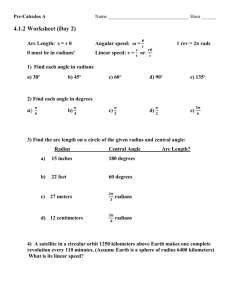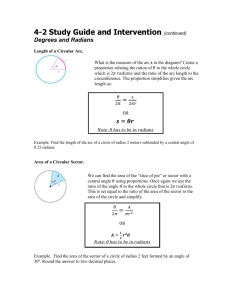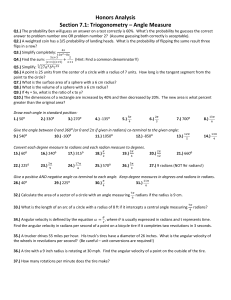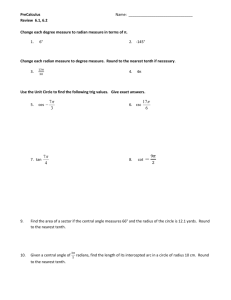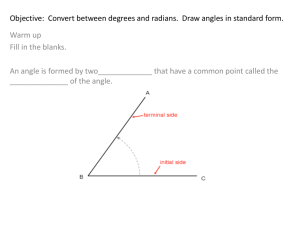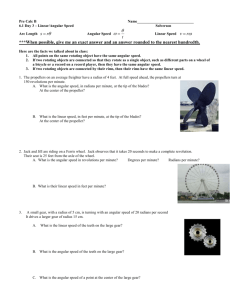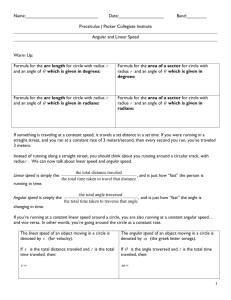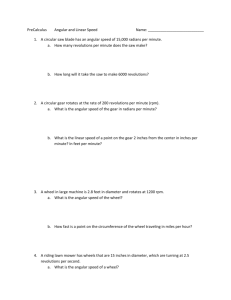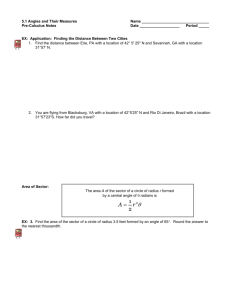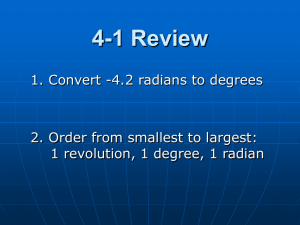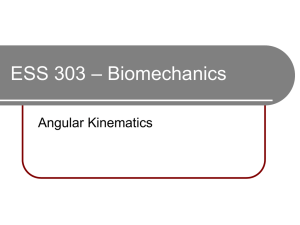MHF 4U Angular speed
advertisement
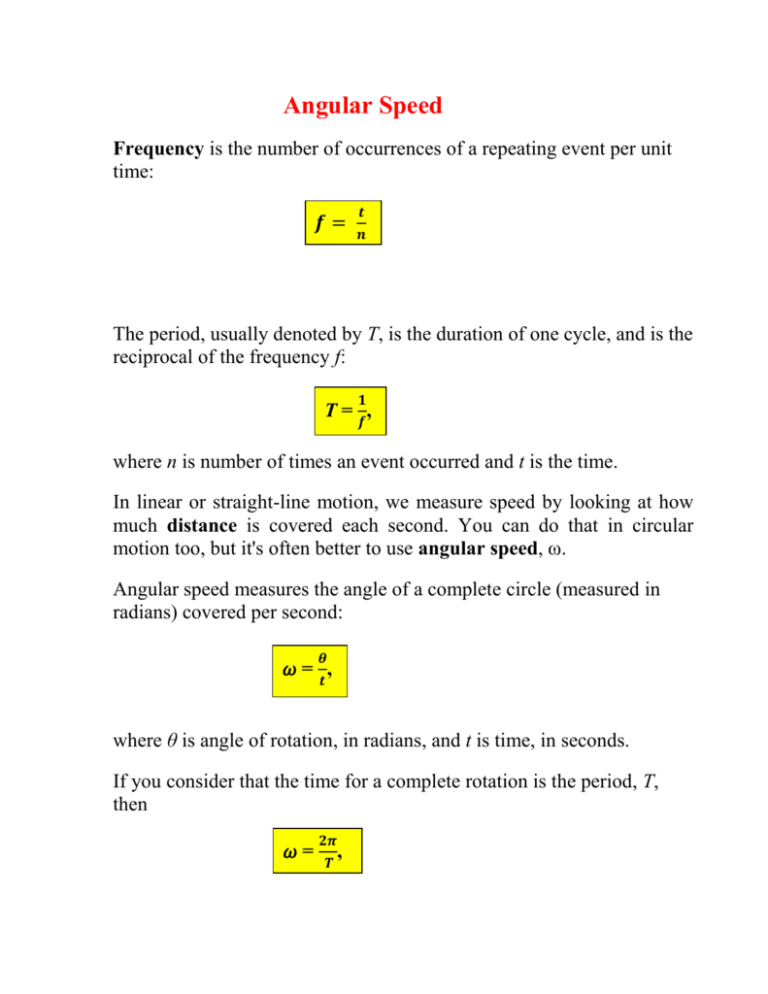
Angular Speed Frequency is the number of occurrences of a repeating event per unit time: 𝒇= 𝒕 𝒏 The period, usually denoted by T, is the duration of one cycle, and is the reciprocal of the frequency f: 𝟏 T= , 𝒇 where n is number of times an event occurred and t is the time. In linear or straight-line motion, we measure speed by looking at how much distance is covered each second. You can do that in circular motion too, but it's often better to use angular speed, ω. Angular speed measures the angle of a complete circle (measured in radians) covered per second: 𝜽 𝜔= , 𝒕 where θ is angle of rotation, in radians, and t is time, in seconds. If you consider that the time for a complete rotation is the period, T, then 𝜔= 𝟐𝝅 𝑻 , because 2π is the angle (in radians) covered when you do a complete 1 circle. Remembering that T = you can also write this as 𝑓 ω = 2πf A traditional unit of measure used with rotating mechanical devices is revolutions per minute, abbreviated rpm. Example An old record player spins records at 45 rpm (revolutions per minute). For a point on the circumference (radius = 10 cm) calculate the angular rad speed in . 𝑠 Answer: f = 45 rpm = 45 60 = 0.75 revolutions per second Angular speed: ω = 2πf = 2π × 0.75 = 4.7 rad 𝑠 The relationship between angular speed and linear speed If you are going round in a circle of radius r, then the distance covered in 1 rotation equals: d = 2πr. The time for one rotation is T, the period. So, linear speed of your motion equals: 𝑣= 𝑑 𝑇 = 2π𝑟 𝑇 = ω𝑟. Thus, the equation 𝒗 = 𝛚𝒓 relates angular and linear speed. Example: The London Eye Ferris wheel has a diameter of 135 m and completes one revolution in 30 min. a) Determine the angular speed, ω, in radians per second. b) How far has a rider travelled in 10 min? Solution: a) T = 30 min = 30 (60 s) = 1800 s 2𝜋 2𝜋 𝑟𝑎𝑑 ω= = = 0.00349 𝑇 1800 b) Radius, r = `135 2 𝑠 m = 67.5 m 𝑡 10 𝑚𝑖𝑛 𝑇 30 𝑚𝑖𝑛 1 Number of revolutions, n = = 1 Distance travelled, d = (2πr) = 3 3 = 1 3 . (2π ∙ 67.5 m) = 45π m ≈ 141.4 m PRACTICE: 1. The earth rotates on its axis once every 24 hours. a. How long does it take Earth to rotate through an angle of 4 3 ? b. How long does it take Earth to rotate through an angle of 120º? 2. Find the length of the arc for each, to 3 decimal places: c. radius of 12cm, central angle 75º d. radius of 8m, central angle of 185º e. radius of 18mm, central angle of 30º 3. If an object moves along a circle of radius r units, then its linear velocity, v, is given by v r , where represents the angular velocity t t in radians per unit of time. Find the angular velocity for each: f. a pulley of radius 8cm turns at 5 revolutions per second. g. A bike tire of diameter 26 inches 3 revolutions per second 4. The formula for the area of a sector of a circle (“pie wedge”) is given as A 1 r 2 , where r is the radius and is the measure of the central 2 angle, expressed in radians. Find the area of each sector described: a. = 315º, diameter is 20 cm. b. = 135º, radius is 16 ft. 5. When is it beneficial to work with angles measured in radians? In degrees? 6. Explain how to convert between radians and degrees. Answers 1. a. 16 h b. 8 h 2. a. 15.708 cm b. 25.831 m. c. 9.425 mm 3. a. 150.796 cm/sec b. 245.044 in/sec 4 . a. 274.889cm2 b. 7.069 ft2 5. It is more beneficial to work in radians if the formula given calls for radians and if working with professionals with a mathematics background. It is more beneficial to work in degrees if the formula given calls for degrees and if working with the general population. 6. To convert radians to degrees, multiply by and simplify. 180 or substitute π = 180º
